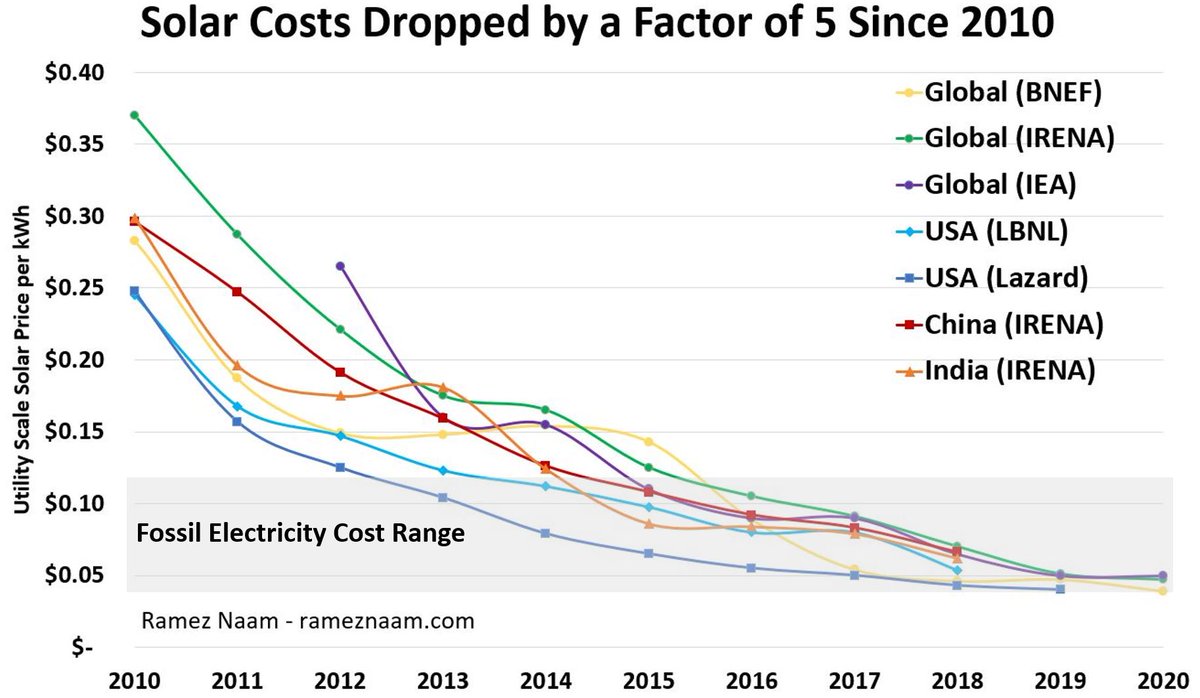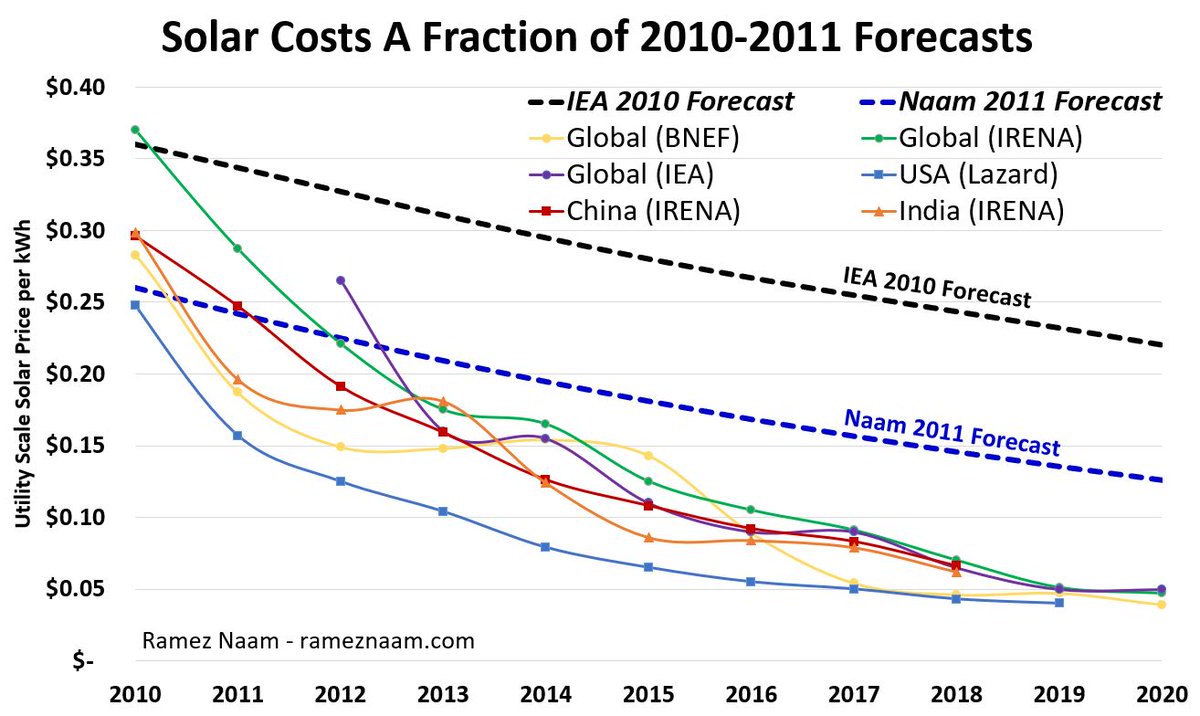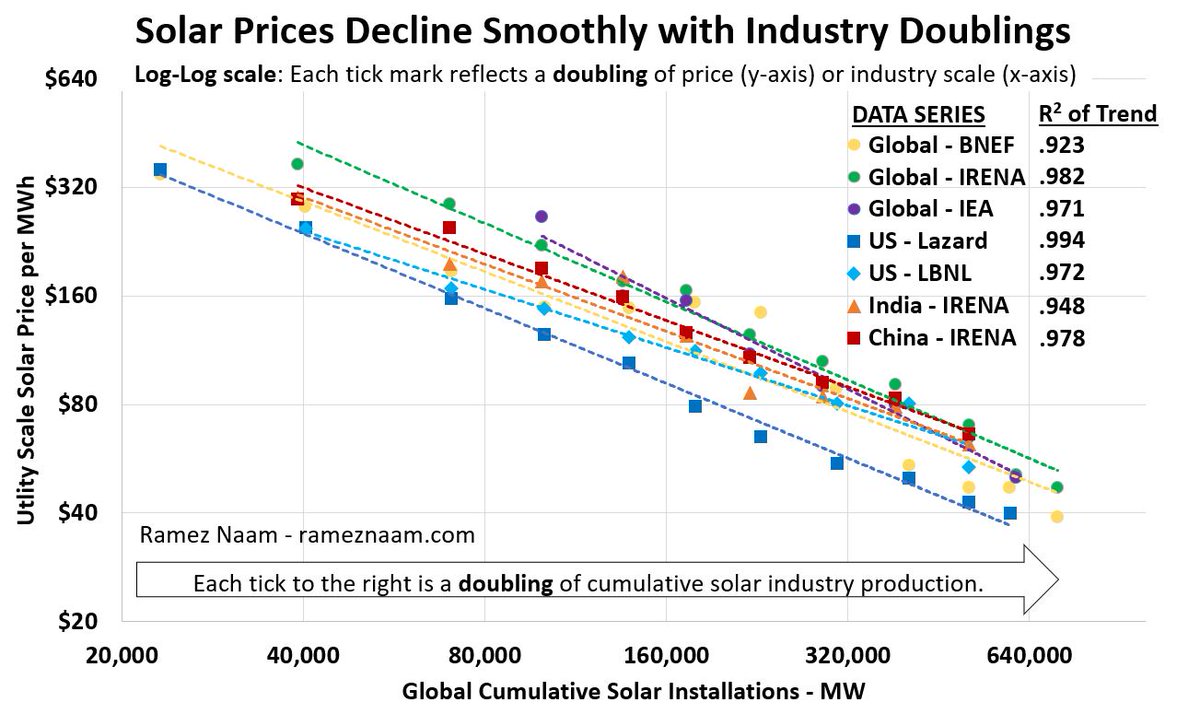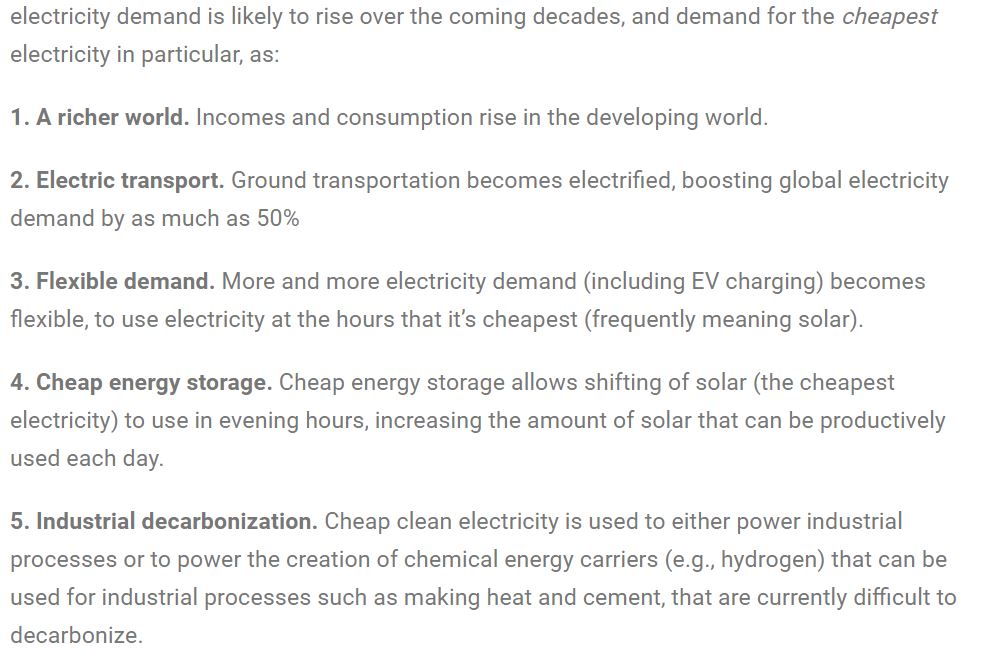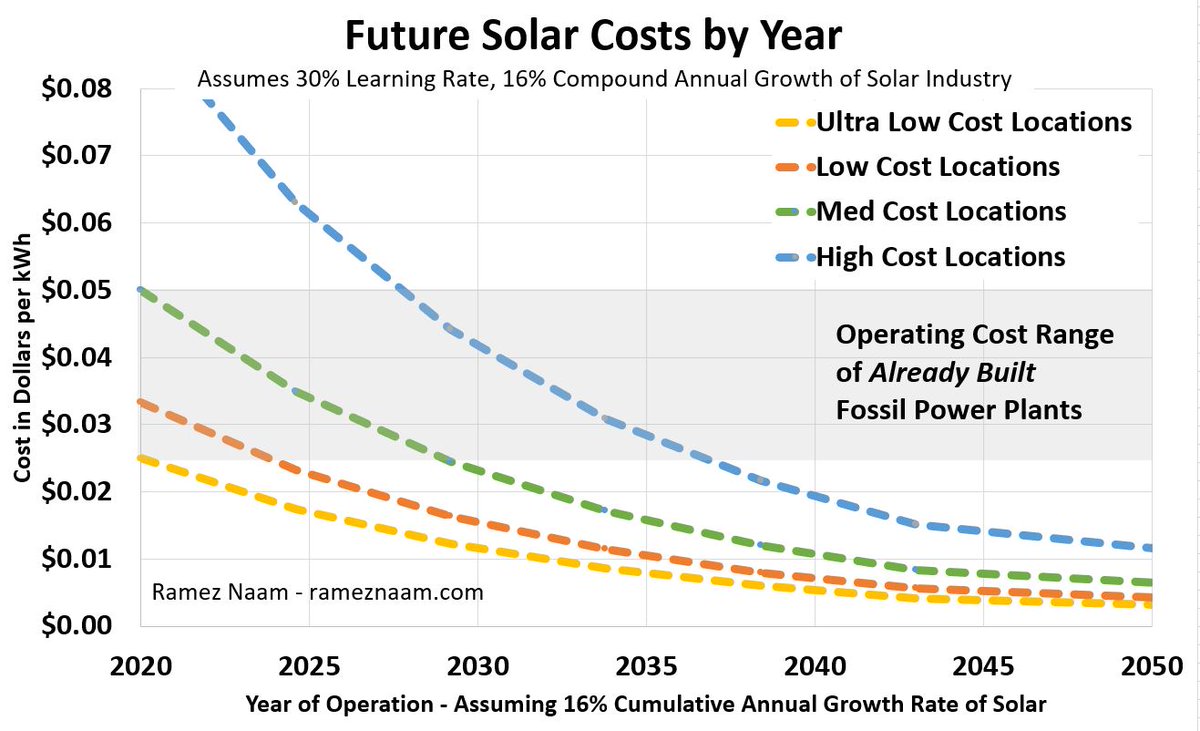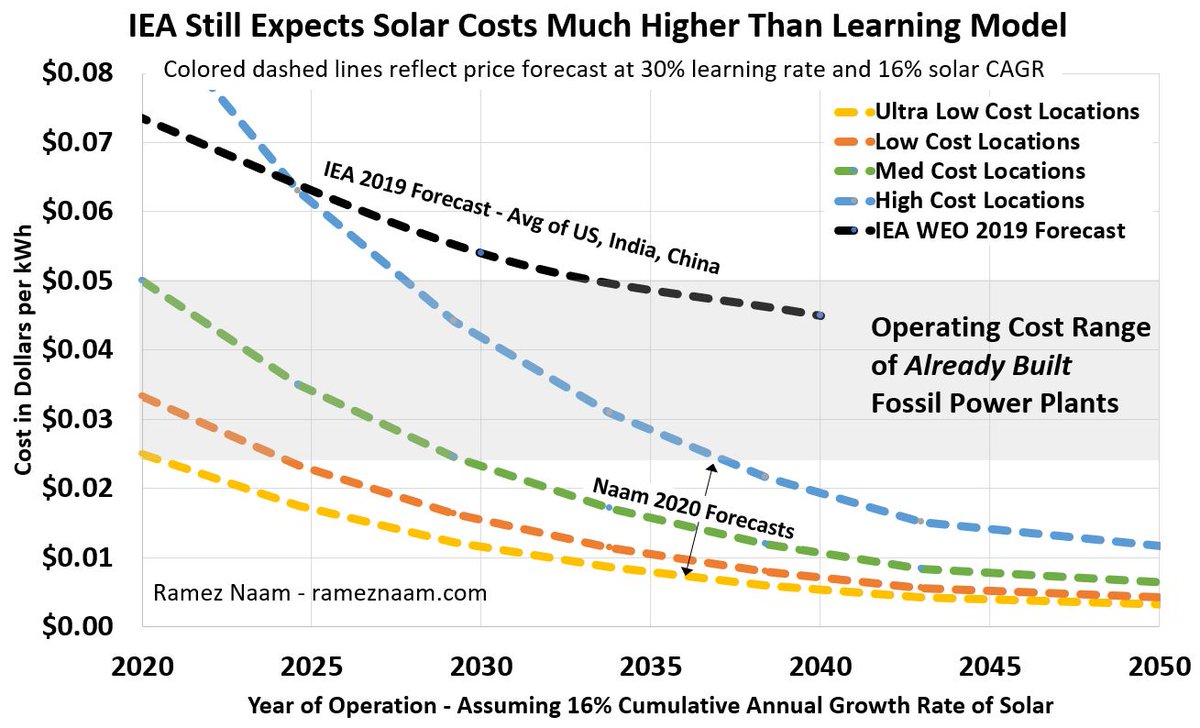THREAD: Solar is plunging in cost faster than anyone, including me, predicted. Today I& #39;m publishing an update of my solar cost forecasts from 2015, with more data & improved methods. Tl;dr: Solar is on path to become insanely, world-changingly cheap. https://rameznaam.com/2020/05/14/solars-future-is-insanely-cheap-2020/">https://rameznaam.com/2020/05/1... 1/20
Over the last decade, from 2010 - 2020, the unsubsidized cost of solar electricity from utility scale projects has dropped by a factor of 5 or more. That& #39;s consistent in global average data, and in the US, India, & China. Solar is now often competitive with new coal or gas. 2/20
Solar has dropped in cost far faster than any forecaster expected. Solar prices in 2020 are half of what I projected in 2011. They& #39;re a quarter of what the IEA projected in 2010. 3/20
Solar costs are now decades ahead of what most forecasts predicted. Solar prices are now:
- 7-10 years ahead of my 2015 forecast.
- 10-15 years ahead of my 2011 forecast.
- 30-40 years ahead of IEA& #39;s 2014 forecast.
- 50-100 years? ahead of IEA& #39;s 2010 forecast. 4/20
- 7-10 years ahead of my 2015 forecast.
- 10-15 years ahead of my 2011 forecast.
- 30-40 years ahead of IEA& #39;s 2014 forecast.
- 50-100 years? ahead of IEA& #39;s 2010 forecast. 4/20
To model future solar costs, we& #39;ll use the learning rate, aka Wright& #39;s Law. It predicts that every doubling of cumulative production of a technology leads to a consistent percent decline in cost. It applies as far back as the Ford Model T. More here: https://spectrum.ieee.org/tech-talk/at-work/test-and-measurement/wrights-law-edges-out-moores-law-in-predicting-technology-developmento">https://spectrum.ieee.org/tech-talk... 5/20
To see if Wright& #39;s Law applies to solar, we need to look at the cost of solar electricity as a function how much solar the world has deployed (rather than solar cost over time). And we can see that solar costs have dropped smoothly as scale has increased. 6/20
That chart is on a linear scale, tho. Wright& #39;s law is an exponential process. Every *doubling* of scale drives a *percent* change in cost. If Wright& #39;s Law holds, then on a log-log graph of cost vs scale, we should see straight lines. We do. And we get excellent fits (R^2). 7/20
And this chart tells us that solar learning is fast. Incredibly fast. Solar electricity costs are dropping by an incredible 30-40% per doubling. That& #39;s consistent across all 7 data series on this chart. 8/20
That& #39;s an incredible, unexpectedly high learning rate. It& #39;s roughly twice the learning rate found in most of the literature, in my 2015 forecast, and in reports from bodies like the IEA and EIA. 9/20
Let& #39;s be conservative and use the low end of this range, a 30% learning rate. At 5 more doublings (32x current scale) the *average* cost of solar in sunny places would be 1 cent /kwh. Ultra-low cost deals would be half a cent. Even northern Europe would see 2 cents. 10/20
Astute readers will see that the far end of that scale is 20 TW of solar, or enough to supply roughly 2/3 of the world& #39;s current electricity demand. That may seem utterly pathological. But there are many reasons to expect higher demand, and more use of the cheapest power. 11/20
What will solar prices look like as a function of time? Here& #39;s what it looks like if we use the IEA& #39;s forecast of 16% annual growth for solar. These are insanely cheap prices, almost everywhere on earth. 12/20
By 2030, solar prices are lower than the *operating cost* of existing coal & gas plants across most of the world. That would lead to economic disruption of those plants, particularly coal plants. I talk about this as the Third Phase of Clean Energy: https://rameznaam.com/2019/04/02/the-third-phase-of-clean-energy-will-be-the-most-disruptive-yet/">https://rameznaam.com/2019/04/0... 13/20
These future solar cost forecasts at a 30% learning rate also project costs far lower than the IEA& #39;s most recent assumptions in their 2019 WEO. By 2030, a 30% learning rate projects solar costs 1/2 of IEA& #39;s assumptions. By 2040, less than 1/4 of IEA& #39;s assumptions. 14/20
Why have past forecasts been so wrong?
1. Academic studies often end at 2011, when less than 10% of today& #39;s solar had been built.
2. IEA/EIA use much lower learning rates.
3. My 2015 forecast used US scale, instead of global scale, to find the learning rate. 15/20
1. Academic studies often end at 2011, when less than 10% of today& #39;s solar had been built.
2. IEA/EIA use much lower learning rates.
3. My 2015 forecast used US scale, instead of global scale, to find the learning rate. 15/20
Solar this cheap, if it arrives, will have a massive impact. Itll help decarbonize electricity. It& #39;ll also help decarbonize industrial processes that use direct heat today, either by electrifying them, or by creating cheaper green hydrogen. More in a future post. 16/20
At the same time, this forecast of cheap solar is NOT a panacea.
1. Learning could slow, or prices could hit a floor.
2. We need cheap storage for evenings.
3. We need cheap winter electricity in places like Europe, when days are short, & electricity demand is high.
17/20
1. Learning could slow, or prices could hit a floor.
2. We need cheap storage for evenings.
3. We need cheap winter electricity in places like Europe, when days are short, & electricity demand is high.
17/20
In short, we need to continue to push for policies that help scale solar and fund additional innovation, and also continue to push for deployment & innovation in complementary energy sources like wind, geothermal, and nuclear. 18/20
All the same, this incredible pace of technological innovation - which was kickstarted by pro-solar policies in places like Germany - should give us a measure of hope. We have enormous innovative capabilities which we can bring to bear. 19/20
Finally, thanks to everyone on energy twitter for conversations on this topic & for encouraging me to publish this. Thanks to @NatBullard for making BNEF data available to me. And to @azeem for sending a sneak peak to @ExponentialView
Full article here: https://rameznaam.com/2020/05/14/solars-future-is-insanely-cheap-2020/">https://rameznaam.com/2020/05/1...
Full article here: https://rameznaam.com/2020/05/14/solars-future-is-insanely-cheap-2020/">https://rameznaam.com/2020/05/1...

 Read on Twitter
Read on Twitter